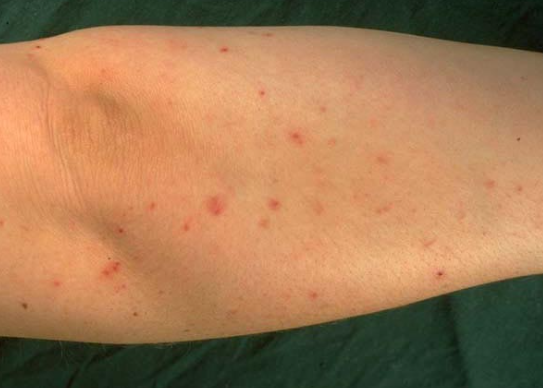Acariasis - is a dermatosis that occurs in the areas of tick bites, which parasitize on animals (birds, reptiles) or are found on various types of plants, food products, organic waste, or in the soil. ICD-10 code: B88.0.
Acariasis is fairly common, especially in certain geographical areas, but it often goes unrecognized. The most common forms of acariasis are various forms of animal scabies or pseudosarcoptic mange.
The most common forms include canine scabies (caused by Sarcoptes scabiei canis), feline scabies (caused by Notoedres cati), and scabies in rabbits and other domestic animals. Cheyletiella (0.3-0.5 mm), an ectoparasitic mite of dogs (Cheyletiella yasguri), cats (Cheyletiella blakei), and rabbits (Cheyletiella parasitivorax), can also affect humans and cause severe itching.
Bird mites that infest domestic or wild birds that nest near human habitation can also parasitize humans.
The most common species in Europe is Neotrombicula autumnalis (1-2 mm), which lives on plants and feeds on small arthropods. The larvae (0.2-0.3 mm), known as chiggers, can attack humans. The disease is known as trombiculiasis.
Mites of the genera Tyrogliphus and Glyciphagus (0.4-0.5 mm) can cause outbreaks among personnel in warehouses and grocery stores. Pyemotes ventricosus (0.16-0.22 mm) may also occasionally parasitize humans.Acariasis is characterized by erythematous-vesicular or erythematous-papular lesions, sometimes with small vesicles or pustules. The lesions cause intense itching and are localized on exposed skin areas or along the edge of tight-fitting clothing. The absence of burrows is an important feature in the differential diagnosis of scabies. Infection may be direct or indirect, e.g. through clothing or seats. Symptoms appear immediately after contact with infected animals. The infection rapidly regresses after discontinuing contact with infected animals or with appropriate treatment, but reoccurs each time the patient comes into contact with infected animals.
Bites from ornithonyssus mites of the genus Ornithonyssus (O. bacoti, 0.8-1.4 mm) and Dermanyssus gallinae, parasites of domestic birds and mice, cause severe itching and numerous, often hemorrhagic papules in humans.- Scabies
- Papular urticaria
- Prurigo
- Lichen planus
- Dermatitis herpetiformis
- Drug eruptions
General Treatment Recommendations:
Treatment of acariasis is not strictly necessary, as the dermatosis heals spontaneously upon discontinuation of contact with the infected animal. For tick infestation, repellents such as dimethyl phthalate, benzyl benzoate, and permethrin may be used to treat clothing. Aerosols containing pyrethroids, malathion, or propoxur may also be used.
Recommended treatment methods:- Creams and ointments with sulfur.
- Benzyl benzoate.
- Topical lindane (unavailable in some countries).
- Permethrin.

